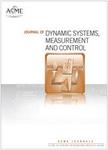版权所有:内蒙古大学图书馆 技术提供:维普资讯• 智图
内蒙古自治区呼和浩特市赛罕区大学西街235号 邮编: 010021

作者机构:CASE WESTERN RESERVE UNIVCTR AUTOMAT & INTELLIGENT SYST RESCLEVELANDOH 44106 CASE WESTERN RESERVE UNIVDEPT ELECT ENGN & APPL PHYSCLEVELANDOH 44106
出 版 物:《JOURNAL OF DYNAMIC SYSTEMS MEASUREMENT AND CONTROL-TRANSACTIONS OF THE ASME》 (美国机械工程师学会汇刊: 动力系统、测量与控制杂志)
年 卷 期:1991年第113卷第3期
页 面:363-370页
核心收录:
学科分类:12[管理学] 1201[管理学-管理科学与工程(可授管理学、工学学位)] 08[工学] 0804[工学-仪器科学与技术] 0811[工学-控制科学与工程]
主 题:Nonlinear systems Dynamics (Mechanics) Control algorithms Systems theory Uncertainty Modeling Feedback Control equipment Time optimal control Robots Transients (Dynamics)
摘 要:A technique is presented for controlling second-order, nonlinear systems using a combination of bang-bang time-optimal control, sliding-mode control, and feedback linearization. Within the control loop, a state space evaluation of the system classifies the instantaneous dynamics into one of three regions, and one of three corresponding control algorithms is invoked. Using a prescribed generation of desirable sliding surfaces, the resulting combined controller produces nearly time-optimal performance. The combination controller is provably stable in the presence of model uncertainty. Experimental data are presented for the control of a General Electric GP132 industrial robot. The method is shown to achieve nearly time-optimal motion that is robust to modeling uncertainties. Representative transients compare favorably to bang-bang control and PD control.